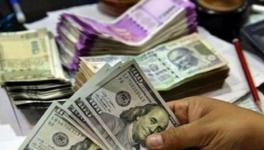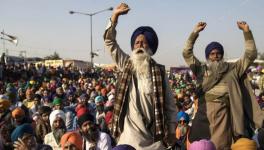COVID-19: Lockdowns Are Back - What About Our ‘V-shaped’ Recovery?
On Monday, April 19, India reported 2.59 lakh new COVID-19 cases and 1,721 deaths in 24 hours. Many states including Maharashtra, Delhi and Gujarat are struggling to cope with the increasing case-load as supplies of oxygen, hospital beds and vaccinations fall short. Lockdowns are back, even though less stringent than the last year. The Indian economy, which was on its way to slow and asymmetric recovery, is bound to be hit again.
According to a report by Barclays India, localised lockdowns in key economic hubs can cost the Indian economy an average of $1.25 billion every week. This may translate into a total loss of around $10.5 billion by the end of May. A report by Wall Street brokerage, Bank of America (BofA) Securities estimated that India’s GDP is unlikely to achieve the earlier projected growth of 3% for the March quarter in 2020-21.
In January 2021, the Economic Survey had forecast a ‘V-shaped’ recovery for the economy and a real GDP growth of 11% in 2021-22. In the first quarter of Financial Year (FY) 2020-21, the economy had suffered a contraction of a massive 23.9% which was followed by a decline of 7.5% in the second quarter. The Survey also noted that despite an annual contraction, India’s policies had helped the country significantly reduce the impact of the pandemic on economic growth.
The claims of a V-shaped recovery of the Indian economy have been contested by analysts. As the situation begins to exacerbate rapidly, it is fitting to take stock of how the economic situation of the country has panned out in the last one year.
While the official figures fixated the economic contraction during the period between April and June to be 23.9%, prominent economist Arun Kumar estimated the actual decline in GDP for this period to be a whopping 47%. He argued that these estimates account for the unorganised sector of the economy which is not captured by the annual GDP data. The unorganised sector constitutes more than 90% of the work force in India. In September 2020, Kumar had also estimated that the pandemic had resulted in close to 80 crore Indians or 60% of the people falling below the internationally defined poverty line.
Also read: Mr. Modi, Any Plan for the Economy?
In January 2020, Kumar estimated the rate of growth for the fiscal year 2020-21 to be -29%. At the same time, the Reserve Bank of India (RBI) and National Statistical Office (NSO) projected the economy to contract by 7.5% and 7.7%, respectively, in FY 2020-21. In its second advanced estimates, the Monetary Policy Committee (MPC) of RBI said that in 2020-21 the economy is expected to suffer a GDP contraction of 7.96%. Whereas, NSO placed its second advanced estimates of GDP contraction for 2020-21 at 8%.
The 2021-22 Budget pegged the nominal GDP growth for the year at 14.4%. However, taking the second wave into consideration, MPC revised the projection for 2021-22 to 10.5% - 26.2% for Quarter 1, 8.3% for Quarter 2, 5.4% for Q3 and 6.2% for Q4. Taking into account the velocity and fatality during the second wave of COVID-19 in India, it remains to be seen how much of this projected growth can be achieved.
About the projection of a V-shaped recovery, it has been argued that this growth will be an optical one. The Indian economy would essentially be recovering from the contraction that it faced in the first half of FY 2020-21. According to estimates by Crisil, by the end of 2020-22, the GDP will only be higher than March 2020 level by an approximate 2%. It also estimated that absolute GDP will be 10% below its pre-pandemic level.
In fact, contesting the claims of V-shaped recovery, former Governor of Central Bank Duvvuri Subbarao argued that rising inequalities as a result of the pandemic are bound to hurt consumption and growth prospects, thereby leading to a K-shaped recovery. Growing inequalities erode consumption and demand, and in turn hurt long term growth prospects. A K-shaped recovery represents an uneven rebound as compared to a V-shaped recovery, which suggests a quick return to growth.
However, with the COVID-19 situation worsening day by day, all of these predictions of growth and recovery may just go for a toss now.
As highlighted by Subbarao, growing income and wealth inequalities in the last year have been a cause of concern for economic recovery. While the country’s poor suffered massive income and livelihood losses, the fortunes of India’s big corporations and richest Indian continued to soar. The wealth of three richest Indians alone increased by over Rs. 7.4 trillion in the last one year. At the same time, millions have suffered major loss of income and livelihood. Large scale pauperisation of the population is bound to lead to a decline in consumption and demand in the economy.
Ever since the first lockdown was announced in March 2020, a number of prominent economists have argued that spending by the government ought to increase to effect a demand stimulus required to sustain economic growth. They relentlessly urged the central government to increase spending on cash and food transfers to people for immediate relief in face of a prolonged and debilitating lockdown. The revenue required to affect these measures ought to be mobilised by taxing the skyrocketing wealth and income of the super-rich in India, it was argued.
Also read: Modi Govt and Its Lack of Concern for the Working Class
As opposed to spending more in order to support its population in distress and aid economic growth, data released recently by the International Monetary Fund (IMF) shows that India spent only 3.1% of its GDP in these efforts. The US and UK spent a gargantuan 16.7% and 16.3% of their GDP in response to COVID-19. Even developing countries like China, South Africa and Brazil spent considerably higher proportion of their GDP during the pandemic – 4.7%, 5.5% and 8.3%, respectively.
Instead of resolving the crisis via direct spending, India’s approach has been to incentivise investment by the private sector through continued tax breaks. However, data on GDP and other growth parameters shows that this approach has neither been enough in significantly boosting economic recovery, nor has it helped the poor who ended up struggling for every meal at the time of the previous lockdown.
While a certain section of economists have pegged the recovery of the economy largely on the revival of private consumption by the ultra-rich within the Indian society, expenditure trends reflected that both government and private consumption expenditure continued to contract in the third quarter. Private consumption contracted by 2.3% in the third quarter as compared to 11.3% in the second quarter. The final consumption of the government contracted by 1.1% in the third quarter, as compared to a contraction of 24% in the second quarter.
Data on unemployment and falling industrial output further reflect the dilapidated state of the Indian economy right now. Even before the pandemic, the economy was in distress and the level of unemployment high at 9.1% in the January-March quarter in 2020 (according to Periodic Labour Force Survey data). Additionally, the abrupt lockdown imposed by Prime Minister Modi in March 2020 had resulted in a massive loss of livelihood.
Also read: Difficult to Predict how Many Waves of Covid-19 India will Have’—Vaccine Specialist Sanjay Rai
As reported by the Centre for Monitoring Indian Economy (CMIE), the unemployment rate had reached 23.52% by the end of April 2020. This was followed by 21.73% and 10.18% in May and June 2020. Throughout the second half of 2020, the unemployment rate remained above 6.5%, reaching a high of 9% in December 2020. With the new wave of lockdowns, unemployment rates have begun to rise again. For the week ending April 18, 2021, the unemployment rate was recorded at 7.4% by CMIE.
In February 2021, industrial production contracted by 3.6% for the second straight month owing to poor performance by the manufacturing and mining sectors according to data released by NSO. While the manufacturing sector (constituting 77.63% of the index of industrial production) declined by 3.7%, the output of the mining sector declined by 5.5% in February 2021. In March 2020, the IIP had plummeted by 18.7% and remained in the negative until August 2020. Growth in industrial production has continued to fluctuate since then.
The figures quoted above clarify that the hopes and cheer around ‘green shoots’ and ‘V-shaped’ recovery are hardly substantiated by hard data corresponding to the real economy in India. As COVID-19 rages back with greater ferocity, lockdowns are back with varying intensity. What appeared to be sluggish revival will fast turn into a frightening economic crisis alongside a total collapse of the healthcare infrastructure in the country, yet again.
(The writer is an author and a Research Associate with NewsClick. The views are personal.)
Get the latest reports & analysis with people's perspective on Protests, movements & deep analytical videos, discussions of the current affairs in your Telegram app. Subscribe to NewsClick's Telegram channel & get Real-Time updates on stories, as they get published on our website.























